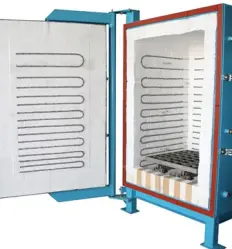Carbon Fiber Furnaces
Carbon fiber, alternatively graphite fiber, carbon graphite or CF, is a material consisting of fibers about 5–10 micrometer in diameter and composed mostly of carbon atoms. The carbon atoms are bonded together in crystals that are more or less aligned parallel to the long axis of the fiber. The crystal alignment gives the fiber high strength-to-volume ratio (makes it strong for its size). Several thousand carbon fibers are twisted together to form a yarn, which may be used by itself or woven into a fabric.
The properties of carbon fibers, such as high flexibility, high tensile strength, low weight, high resistance, high temperature tolerance and low thermal expansion, make them very popular in aerospace, civil engineering, military, motorsports and other competition sports. However, they are relatively expensive when compared to similar fibers, such as glass fibers or plastic fibers. Carbon fibers are usually combined with other materials to form a composite. When combined with a plastic resin, and wound or molded, it forms carbon fiber reinforced plastic (often referred to as carbon fiber) which is a very high strength-to-weight, extremely rigid, although somewhat brittle, material. However, carbon fibers are also composed with other materials, such as with graphite to form carbon composites, which have a very high heat tolerance.
Applications
Carbon fiber is most notably used to reinforce composite materials, particularly the class of materials known as carbon carbon components or graphite-reinforced polymers. Non-polymer materials can also be used as the matrix for carbon fibers. Due to the formation of metal carbides and corrosion considerations, carbon has seen limited success in metal matrix composite applications. Reinforced Carbon-Carbon (RCC) consists of carbon fiber-reinforced graphite and is used structurally in high-temperature applications. The fiber also finds use in filtration of high-temperature gases, as an electrode with high surface area and impeccable corrosion resistance and as an anti-static component. Molding a thin layer of carbon fibers significantly improves fire resistance of polymers or thermoset composites because a dense, compact layer of carbon fibers efficiently reflects heat.






